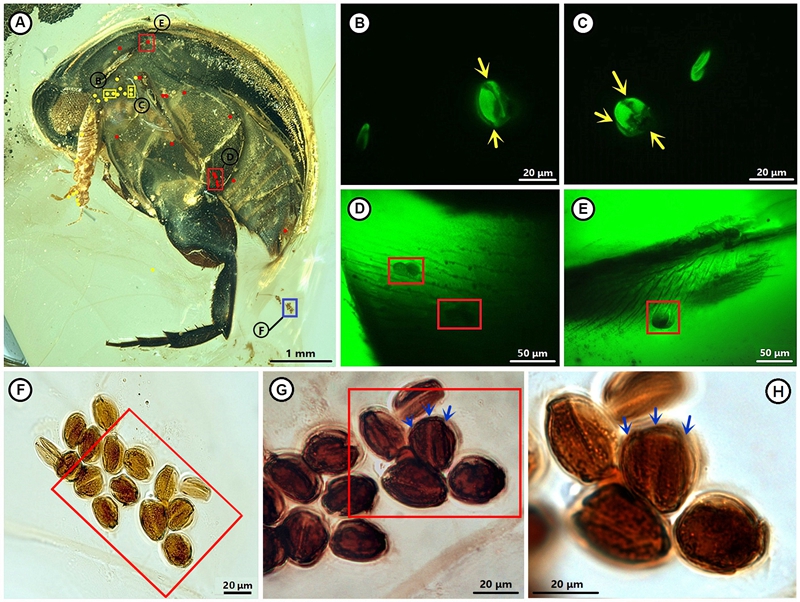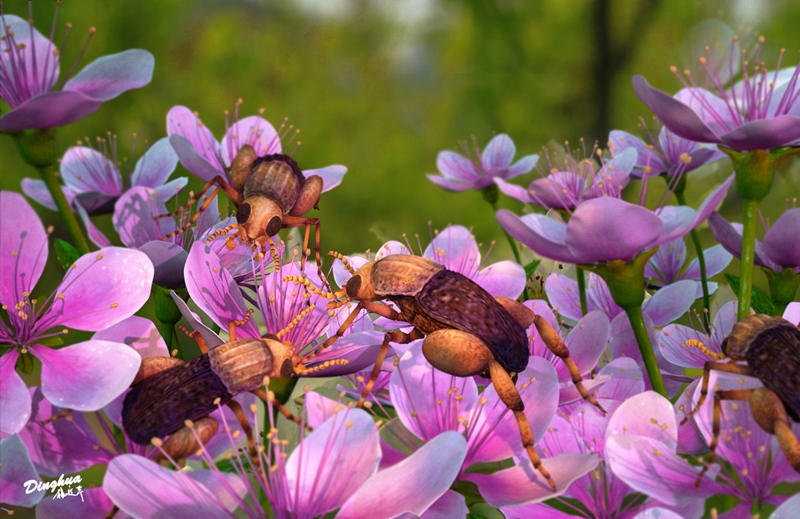Most of our food is from angiosperms, while more than 90% of angiosperms require insect pollination – making this pollination method hugely important. Nevertheless, scientists have long been unclear as to when insect pollination first appeared.
Now, however, an international research group from China and the U.S. has provided the earliest evidence of insect-angiosperm pollination – by analyzing a sample of Cretaceous Burmese amber. The research was led by Prof. WANG Bo from the Nanjing Institute of Geology and Palaeontology (NIGPAS) of the Chinese Academy of Sciences. Results were published in Proceedings of the National Academy of Sciences (PNAS) on November 11.
Angiosperms, also known as flowering plants, originated in the Mesozoic and are the most diverse group of land plants, with approximately 300,000 known species. Their most distinguishing characteristic is the presence of true flowers. Angiosperms self-pollinate as well as use insects, animals, wind and water to achieve pollination, thus enhancing gene flow and increasing diversity.
Angiosperms experienced rapid radiation by the mid-Cretaceous, which Darwin called an “abominable mystery.” Since Darwin’s time, numerous scholars have thought that insect pollination must be a key contributor to the Cretaceous radiation of angiosperms since insects and flowering plants were both common by this time. However, direct evidence of a Cretaceous insect-angiosperm pollination mode was missing and related theories remained hypothetical until now.
Working with Burmese amber dating to the mid-Cretaceous – 99 million years ago – the researchers discovered evidence of beetle pollination, thus confirming the hypothesis of Cretaceous insect-angiosperm interaction and offering the earliest evidence for entomophily.
The beetle specimen in the amber sample is a new species within the family Mordellidae, named Angimordella burmitina. Extant Mordellidae beetles are a typical flower-visiting group. Commonly, they are known as “tumbling flower beetles” for the irregular movements they make when escaping predators, due to having an elongated pygidium (an external posterior body part or shield in arthropods).
A. burmitina is distinguished from most extant species by a poorly developed pygidium and enlarged, very well-developed hind legs. Based on these features, the scientists believe A. burmitina utilized a different movement mechanism than other species, preferring to jump or fly between corollas and plants. The mouth part of A. burmitina is also highly evolved for pollen collection, with enlargement of part of the maxillary palps, which are leg-like structures near the mouth.
Numerous pollen grains were preserved on or near the A. burmitina specimen. To examine them closely, the research team performed high-precision grinding and polishing of the amber sample, then applied confocal laser scanning microscopy and optical photomicrography. Using these methods, the scientists identified the pollen grains as tricolpate, meaning they each have three pores and come from a type of flowering plant known as a eudicot. Their surface texture, size, and clumping also show that the pollen is zoophilous, making it more likely to be picked up by an animal such as a beetle.
Based on the entomological and palynological evidence, the research team believes this amber specimen reveals a beetle-angiosperm pollination mode, supporting the hypothesis that specialized insect pollination modes were present in eudicots at least 99 million years ago. Previous evidence of insect pollination of flowering plants dates to the Middle Eocene, around 45-48 million years ago. Thus, the current finding extends the history of insect pollination of flowering plants by around 50 million years and suggests that such mutualism existed at least as far back as 99 million years ago.
Reference: Bao Tong,Wang Bo, Li Jianguo, Dilcher D. (2019) Pollination of Cretaceous flowers.PNAS, doi:10.1073/pnas.1916186116.

Cretaceous tumbling flower beetle and tricolpate pollen grains.(Imaged by NIGPAS)

Ecological reconstruction of the Cretaceous tumbling flower beetle.(Imaged by NIGPAS)
Download:
